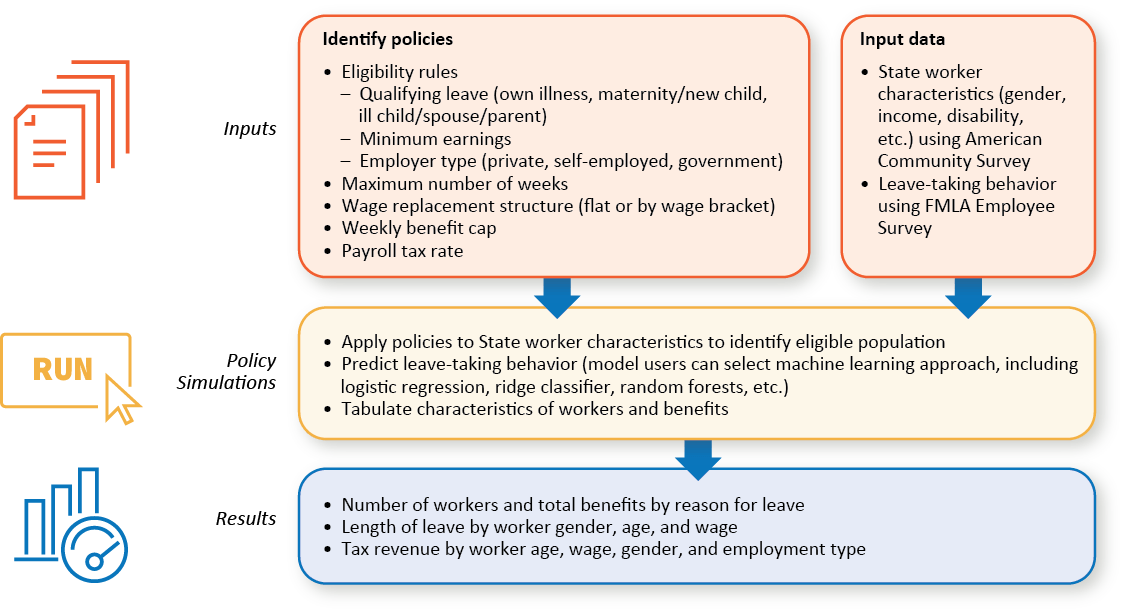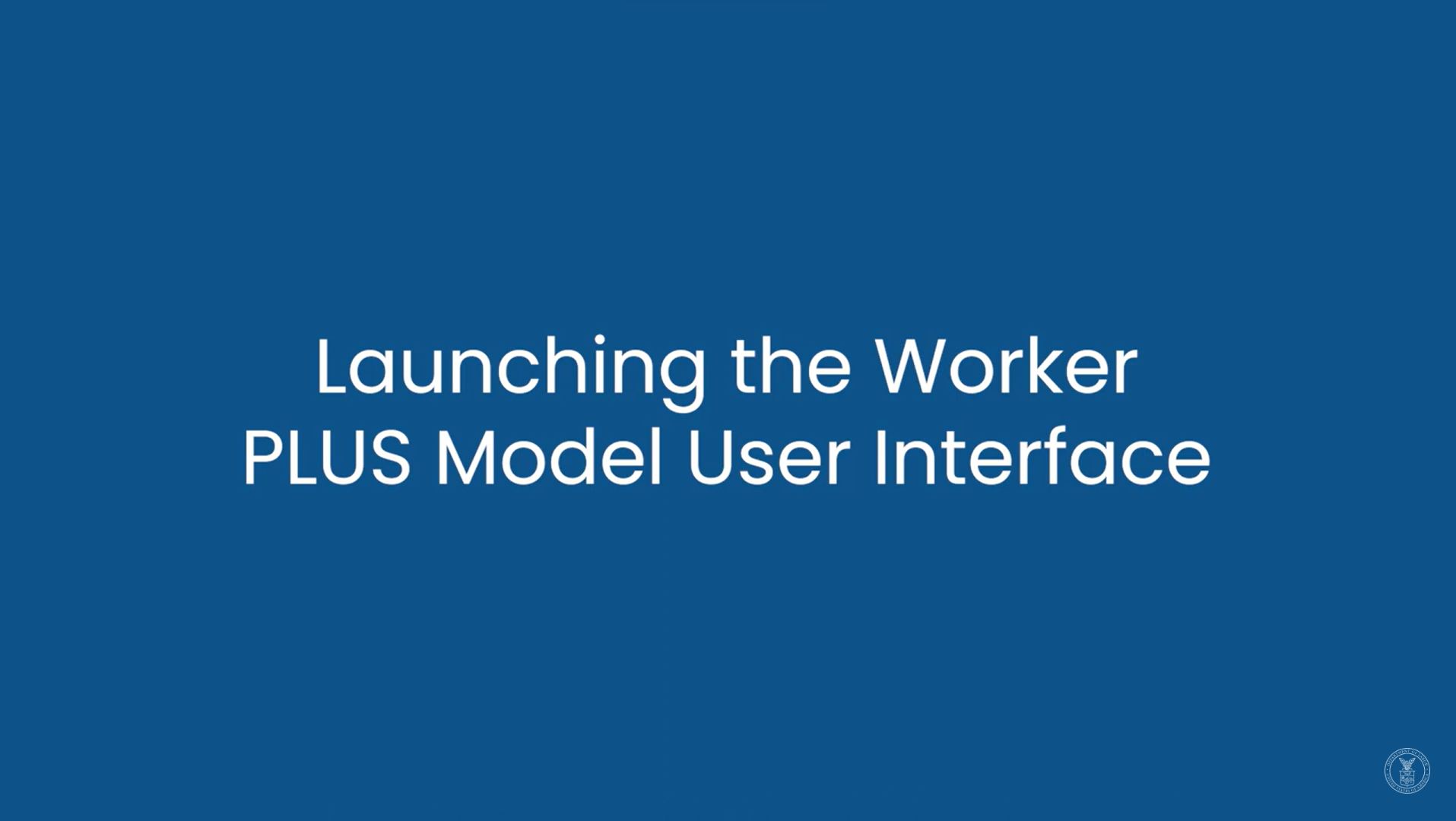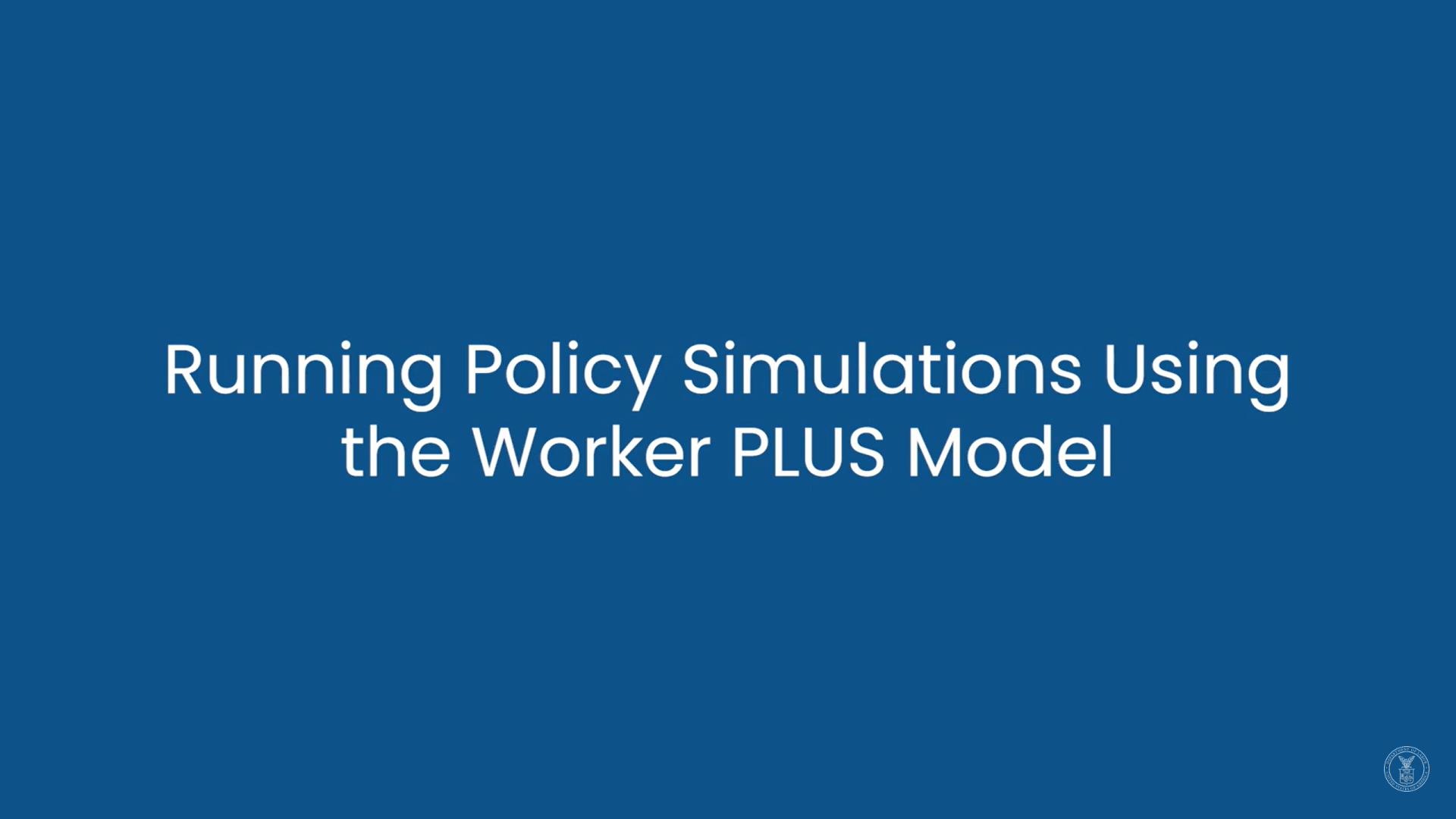About the Study
In 2017, the Chief Evaluation Office (CEO) funded contractors IMPAQ International and the Institute for Women’s Policy Research (IWPR) to conduct the Microsimulation Model on Worker Leave. The goal of the study was to produce an updated, open-source, publicly available simulation tool based on the Albelda Clayton-Matthews/IWPR Paid Family and Medical Leave Simulation Model (ACM model). The resulting Worker Paid Leave Usage Simulation (Worker PLUS) is an open-source simulation tool that can be used by researchers and federal, state, and local policy makers to estimate the effects of various worker leave scenarios and policy options on worker leave-taking behavior, and to estimate the benefits paid as well as costs of administering any given program.
The Worker PLUS model employs public microdata from the Department of Labor’s Family and Medical Leave Act (FMLA) Employee Survey to train models for individual-level leave needs and behaviors. When a user inputs paid leave program parameters, the model simulates specific leave-taking behavior and outcomes using demographic data from the five-year American Community Survey (ACS) Public Use Microdata Sample (PUMS). The simulation engines have been developed in both Python and R, two of the most popular open-source programming languages, and the model code is fully transparent and publicly available to facilitate future data updates and model development. The model offers a graphical interface for increased accessibility by non-technical users.
Users can download all of the files needed to install and run the Worker PLUS simulator below, as well as a user manual and data dictionary. A companion to the simulation model, users can find a resource document that reviews the different types of administrative costs observed in planned and extant state-level paid family and medical leave programs and how these costs vary across states, and an Excel template that helps user plan, estimate and test the administrative costs of running a new program. A series of issue briefs also accompany the simulator to help researchers, policy analysts, and the public understand and use the Worker PLUS model. The issue briefs explore example simulations, model testing, and benchmarking studies.
The DOL-funded study is a result of the annual process to determine the Department’s research priorities for the upcoming year. It contributes to the labor evidence base to inform data, methods, and tools and worker leave programs and policies and addresses Department strategic goals and priorities.
How Worker Paid Leave Usage Simulation Works

Worker Paid Leave Usage Simulation Video Tutorials
 Launching the Worker PLUS Model User Interface
Launching the Worker PLUS Model User Interface Running Policy Simulations Using the Worker Plus Model
Running Policy Simulations Using the Worker Plus Model
Audio described versions of Launching the Worker PLUS Model User Interface and Running Policy Simulations Using the Worker Plus Model are also available.
- Worker Paid Leave Usage Simulation (Worker PLUS) Microsimulator Tools/Videos
- Infographic: Overview of the Worker PLUS Model (October 2023)
- Quick-Start Guide (October 2023)
A quick overview for launching the Worker Paid Leave Usage Simulation (Worker PLUS) model
- 2023 Worker PLUS Microsimulator (October 2023)
The 2023 Worker Plus Microsimulator provides updates to the program to allow for recent versions of R or Python and updated data from 2020, and also allows analysis incorporating the 2016, 2017, and 2018 datasets. In addition to the data files, the 2023 Worker PLUS model also contains an updated User Manual and Data Dictionary. - 2018 Worker PLUS Microsimulator (March 2021)
The 2018 Worker PLUS Microsimulator contains data files for 2016, 2017, and 2018, along with the 2018 User Manual and Data Dictionary. - Resources
- A Review of the Administrative Costs of Establishing a State Paid Family and Medical Leave Program (March 2021)
An examination of different types of administrative costs observed in planned and extant state-level paid family and medical leave programs and how these costs vary across states.- Administrative Cost Excel Template for Paid Family and Medical Leave Programs
An Excel template to help calculate the cost for a paid family and medical leave program.
- Administrative Cost Excel Template for Paid Family and Medical Leave Programs
- Issue briefs (March 2021)
- Introduction to Issue Brief Series
- A Guide to Performing Example Simulations
A step-by-step guide to performing example simulations using the Worker PLUS model. - Estimating Impacts of Leave Policies on Low-Wage Workers
A set of hypothetical examples show users how to use the Worker PLUS model to analyze the impacts of moving from an upaid leave system to a system that include a paid leave program, focusing on low-wage workers. - A Guide to Performing a Policy Simulation of a Parental Leave Program for Federal Civilian Employees
An example policy simulation that shows how the Worker PLUS model can predict the effects of a parental leave program for federal civilian employees. - Model Testing
A summary of model testing and validating efforts using data from 2018 FMLA Employee Survey, the 2014–2018 American Community Survey Public Use Microdata Sample; and benefit outlay data published by state paid leave programs in California, New Jersey, and Rhode Island. - A Benchmarking Study of the Worker PLUS Model Results
A summary of a benchmark study in which the results from the Worker PLUS model are compared to those from the 2017 ACM model and actual program administrative data. - Benchmarking Results of the Benefit Financing Module’s Payroll Tax Revenue Estimates
A summary of a benchmark study in which the researchers compared payroll tax revenue estimates using the Worker PLUS model’s Benefit Financing module with actual state tax revenue numbers from three states, finding that the module underestimated the payroll tax revenue by about 10 percent to 15 percent.
- A Review of the Administrative Costs of Establishing a State Paid Family and Medical Leave Program (March 2021)
- The Worker PLUS simulation model uses updated public microdata and predictive modelling to allow users to:
- Simulate different scenarios of a paid leave program
- Estimate the program benefit costs
- Estimate payroll tax revenue needed to fund the program benefit costs
- Perform population analyses for program participants and eligible workers by focusing on their leave-taking behavior
- Compare simulation results across different sets of parameter input
- The Worker PLUS model has an additional Benefit Financing module that allows users to estimate payroll tax revenue needed to fund program outlay and the estimated tax burden across demographic subgroups.
- The Worker PLUS model also allows analysis of the effects of a paid leave program on a specific population (such as low-wage workers, or women of childbearing age) and the distribution of program benefits by demographic characteristics.
- In the Estimating Impacts of Leave Policies on Low-Wage Workers issue brief, researchers implemented a hypothetical simulation using data from workers in Maryland and found the adoption of a paid leave program is progressive in that it benefits low-wage workers and their families more than the higher-wage groups. Among low-wage workers, the simulation predicts about a 10 percent increase in the number of leave takers and the low-wage workers account for 52% of all program participants.
- In A Guide to Performing a Policy Simulation of a Parental Leave Program for Federal Civilian Employees, researchers performed a policy simulation of a recently signed law under which a new parental leave program would be implemented among federal civilian workers. With the model parameters configured to best reflect the known features of the program, adopting conservative settings for unknown features, and adjusting for leave length caps and eligible population base estimate, the model is shown to produce outlay estimates that are comparable to the Congressional Budget Office’s program cost projection.
- The benchmarking study explained in A Benchmarking Study of the Worker PLUS Model Results shows that the model can predict program outlays and eligible worker counts in similar accuracy as the existing ACM model for the three state-run worker paid leave programs in California, New Jersey, and Rhode Island. The Worker PLUS model predicts program participant counts more accurately than the existing ACM model by directly calibrating take-up rates toward actual participant counts reported by states.
Infographic
IMPAQ International, Institute for Women’s Policy Research, & Summit Consulting, Inc. (2023). Overview of the Worker PLUS Model. Chief Evaluation Office, U.S. Department of Labor.
Quick-Start Guide
IMPAQ International, Institute for Women’s Policy Research, & Summit Consulting, Inc. (2023). Quick-Start Guide to the Worker Paid Leave Usage Simulation (Worker PLUS) Model. Chief Evaluation Office, U.S. Department of Labor.
Report
IMPAQ International. (2021). A Review of the Administrative Costs of Establishing a State Paid Family and Medical Leave Program. Chief Evaluation Office, U.S. Department of Labor.
Excel Template
IMPAQ International. (2021). Administrative Cost Excel Template for Paid Family and Medical Leave Programs. Chief Evaluation Office, U.S. Department of Labor.
Brief
IMPAQ International. (2021). Worker Paid Leave Usage Simulation (Worker PLUS) Model: Introduction to Issue Brief Series. Chief Evaluation Office, U.S. Department of Labor.
Brief
IMPAQ International. (2021). Worker Paid Leave Usage Simulation (Worker PLUS) Model: A Guide to Performing Example Simulations. Chief Evaluation Office, U.S. Department of Labor.
Brief
IMPAQ International. (2021). Worker Paid Leave Usage Simulation (Worker PLUS) Model: Estimating Impacts of Leave Policies on Low-Wage Workers. Chief Evaluation Office, U.S. Department of Labor.
Brief
IMPAQ International. (2021). Worker Paid Leave Usage Simulation (Worker PLUS) Model: A Guide to Performing a Policy of a Parental Leave Program for Federal Civilian Employees. Chief Evaluation Office, U.S. Department of Labor.
Brief
IMPAQ International. (2021). Worker Paid Leave Usage Simulation (Worker PLUS) Model: Model Testing. Chief Evaluation Office, U.S. Department of Labor.
Brief
IMPAQ International. (2021). Worker Paid Leave Usage Simulation (Worker PLUS) Model: A Benchmarking Study of the Worker PLUS Model Results. Chief Evaluation Office, U.S. Department of Labor.
Brief
IMPAQ International. (2021). Worker Paid Leave Usage Simulation (Worker PLUS) Model: Benchmarking Results of the Benefit Financing Module’s Payroll Tax Revenue Estimates. Chief Evaluation Office, U.S. Department of Labor.
The Department of Labor’s (DOL) Chief Evaluation Office (CEO) sponsors independent evaluations and research, primarily conducted by external, third-party contractors in accordance with the Department of Labor Evaluation Policy. CEO’s research development process includes extensive technical review at the design, data collection and analysis stage, including: external contractor review and OMB review and approval of data collection methods and instruments per the Paperwork Reduction Act (PRA), Institutional Review Board (IRB) review to ensure studies adhere to the highest ethical standards, review by academic peers (e.g., Technical Working Groups), and inputs from relevant DOL agency and program officials and CEO technical staff. Final reports undergo an additional independent expert technical review and a review for Section 508 compliance prior to publication. The resulting reports represent findings from this independent research and do not represent DOL positions or policies.
